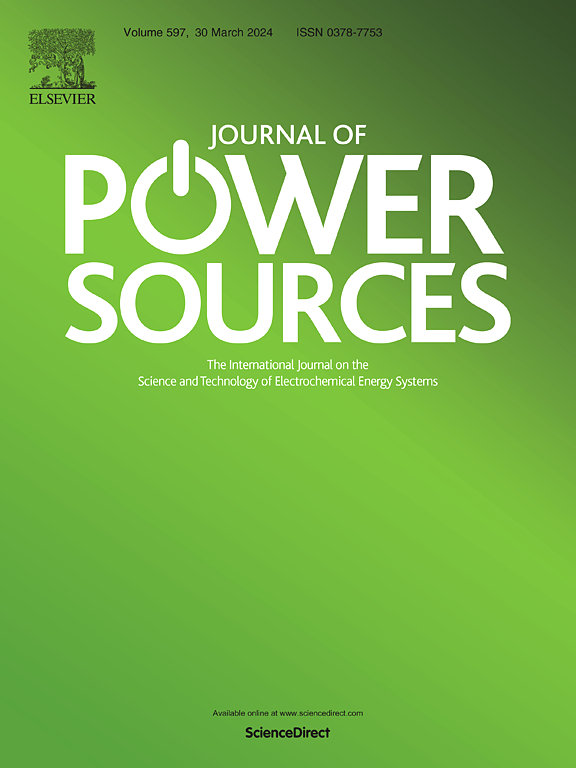First-principles insights into lithium and magnesium ion dynamics for high-performance silicon and silicon-germanium anodes
IF 8.1
2区 工程技术
Q1 CHEMISTRY, PHYSICAL
引用次数: 0
Abstract
Silicon (Si) anodes offer high theoretical capacity for lithium-ion batteries but suffer from severe volume expansion, leading to structural degradation and capacity loss. This study explores silicon-germanium (SiGe) composites as an alternative anode material using Density Functional Theory (DFT) and Ab Initio Molecular Dynamics (AIMD) simulations to evaluate thermodynamic stability, structural adaptability, and charge transport behavior under ion insertion.
The results show that Ge incorporation lowers formation energy barriers, facilitating Li and Mg insertion while reducing mechanical stress and volume expansion. The SiGe framework exhibits greater flexibility, enabling superior Li-ion mobility, while Mg-ion diffusion remains constrained due to stronger electrostatic interactions. Extended AIMD simulations at 300 K, 750 K, and 1200 K further confirm SiGe's structural resilience and improved ion transport. Projected Density of States (PDOS) calculations, along with Electron Localization Function (ELF) analysis, reveal enhanced charge distribution in SiGe, supporting its stability during cycling.
By offering greater thermodynamic stability, reduced volumetric strain, and enhanced ion transport, SiGe presents a promising anode material for next-generation lithium- and magnesium-ion batteries. These findings provide valuable insights into alloy design strategies, bridging the gap between fundamental materials science and practical energy storage applications.
对高性能硅和硅锗阳极的锂和镁离子动力学的第一性原理见解
硅(Si)阳极为锂离子电池提供了很高的理论容量,但其体积膨胀严重,导致结构退化和容量损失。本研究利用密度泛函理论(DFT)和从头算分子动力学(AIMD)模拟,探索了硅锗(SiGe)复合材料作为替代阳极材料,以评估离子插入下的热力学稳定性、结构适应性和电荷输运行为。结果表明,Ge的掺入降低了地层能垒,有利于Li和Mg的插入,同时减小了机械应力和体积膨胀。SiGe框架表现出更大的灵活性,使锂离子迁移率更高,而由于更强的静电相互作用,镁离子扩散仍然受到限制。在300 K, 750 K和1200 K下的扩展AIMD模拟进一步证实了SiGe的结构弹性和改善的离子输运。投影态密度(PDOS)计算以及电子局域化函数(ELF)分析显示SiGe中的电荷分布增强,支持其在循环过程中的稳定性。通过提供更大的热力学稳定性、更小的体积应变和增强的离子传输,SiGe为下一代锂离子和镁离子电池提供了一种很有前途的负极材料。这些发现为合金设计策略提供了有价值的见解,弥合了基础材料科学与实际储能应用之间的差距。
本文章由计算机程序翻译,如有差异,请以英文原文为准。
求助全文
约1分钟内获得全文
求助全文
来源期刊

Journal of Power Sources
工程技术-电化学
CiteScore
16.40
自引率
6.50%
发文量
1249
审稿时长
36 days
期刊介绍:
The Journal of Power Sources is a publication catering to researchers and technologists interested in various aspects of the science, technology, and applications of electrochemical power sources. It covers original research and reviews on primary and secondary batteries, fuel cells, supercapacitors, and photo-electrochemical cells.
Topics considered include the research, development and applications of nanomaterials and novel componentry for these devices. Examples of applications of these electrochemical power sources include:
• Portable electronics
• Electric and Hybrid Electric Vehicles
• Uninterruptible Power Supply (UPS) systems
• Storage of renewable energy
• Satellites and deep space probes
• Boats and ships, drones and aircrafts
• Wearable energy storage systems
 求助内容:
求助内容: 应助结果提醒方式:
应助结果提醒方式:


